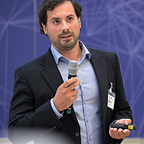The Synergy of AI and IoT — A Convergence of Opportunities:
The fusion of Artificial Intelligence (AI) and the Internet of Things (IoT) is more than just a technological integration; it’s a transformative force reshaping industries. Smart thermostats, for instance, learn user preferences to optimize energy, helping to save and reduce carbon footprints. Businesses are leveraging this synergy to streamline operations and offer enhanced customer experiences. The business landscape is thereby undergoing a profound shift, with AI in IoT spanning sectors from Energy and Manufacturing to Healthcare. AI-powered wearables, for instance, not only monitor vital signs but can also predict potential health issues, alerting medical professionals to abnormalities. Major players like Anagog and Microsoft are pioneering innovations, pushing the boundaries of what’s possible. Microsoft’s Azure IoT Suite, for instance, offers real-time data processing, while IoT’s broader landscape has revolutionized interactions with technology, creating interconnected devices that enhance efficiency and convenience in unprecedented ways.
Market Dynamics and Growth Opportunities
According to industry research Co.’s „global AI in IoT industry research report 2023“ the global AI in IoT market, valued at USD 6074.3 Million in 2022, is projected to reach an impressive USD 15159.58 Million by 2028, showcasing the immense potential and trust industries place in this synergy. Factors propelling this growth include applications in diverse sectors. In automotive, AI-powered IoT doesn’t just enable advanced driver assistance systems but is paving the way for fully autonomous vehicles. However, with great innovation come challenges. Data privacy and security are paramount, given the sensitive nature of the information IoT devices can collect. Companies are heavily investing in cybersecurity measures to protect IoT devices from potential threats. The benefits of AI in IoT are manifold. Efficient data processing, pattern identification, and proactive decision-making are just the tip of the iceberg. For instance, in smart buildings, AI doesn’t just optimize energy consumption; it can also enhance security, manage waste, and even improve air quality by analyzing various data points.
Regional Insights and Global Impact
The AI in IoT market’s growth is not confined to a single region; it’s a global phenomenon. While North America, with its technological advancements, is leading the charge, Europe is not far behind, with cities like Barcelona employing AI and IoT for transformative smart city projects, enhancing urban living and reducing environmental impact. Meanwhile, regions like the Middle East are not just adopting these technologies but aiming to lead in certain sectors. The UAE’s Smart City initiative in Dubai, for instance, is a testament to the region’s ambition. Globally, countries like Japan are not just leveraging AI and IoT for elder care but are also looking at these technologies to address broader societal challenges, such as their aging population. The concept of smart cities is revolutionizing urban living, with advancements in AI, ML, cloud, and 5G driving this transformation.
AIoT — The Next Evolutionary Step
As our lives become more intertwined with the digital realm, the concept of AIoT, signifies a new era where devices are not just interconnected but are also intelligent, adaptive, and predictive. Consider smart refrigerators that not only suggest recipes based on available ingredients but can also order groceries when supplies run low. AIoT tailors products to human needs, enhancing convenience and efficiency. Bosch’s AI-powered oven sensors, for instance, represent just one of the myriad ways AIoT is making a mark. In the industrial sector, the potential is even more profound. Bosch’s advanced semiconductor factory in Dresden showcases how machines equipped with AI can self-optimize, predict maintenance needs, and even adapt to new manufacturing processes on-the-fly.
It’s clear that as AI evolves and is adopted, companies continue to find valuable use cases/application areas, especially when combining multiple technologies — thus reinforcing the importance of staying up-to-date and identifying and addressing potential application areas within your own company at an early stage.
About the author: Guido Perscheid works as a Business Development Manager for the Center for Deep Tech Innovation and is pursuing his PhD at the Chair of Business Informatics at the University of Bamberg. Guido is an expert in innovation management with a focus on technology implementation in the fields of Blockchain, Artificial Intelligence, Internet of Things and Climate Technology.
